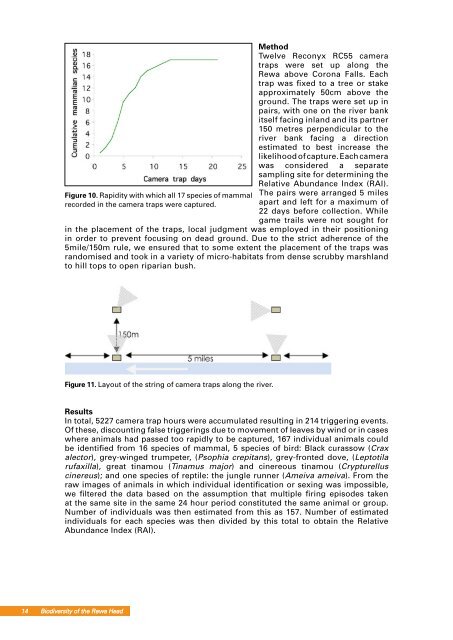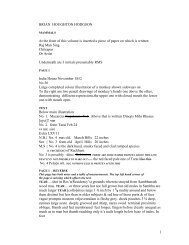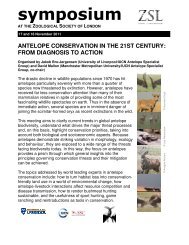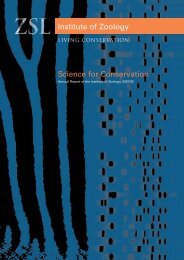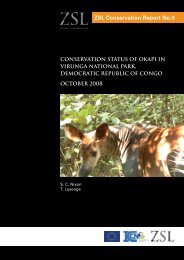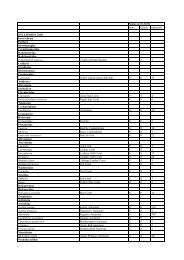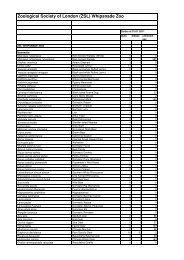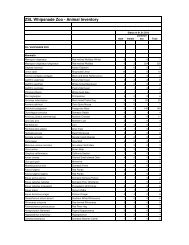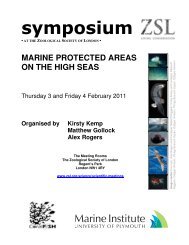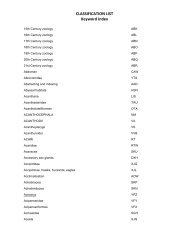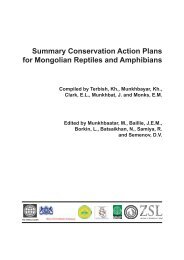Biodiversity of the Rewa Head B Zoological Society of London ...
Biodiversity of the Rewa Head B Zoological Society of London ...
Biodiversity of the Rewa Head B Zoological Society of London ...
You also want an ePaper? Increase the reach of your titles
YUMPU automatically turns print PDFs into web optimized ePapers that Google loves.
Figure 10. Rapidity with which all 17 species <strong>of</strong> mammal<br />
recorded in <strong>the</strong> camera traps were captured.<br />
14 <strong>Biodiversity</strong> <strong>of</strong> <strong>the</strong> <strong>Rewa</strong> <strong>Head</strong><br />
Method<br />
Twelve Reconyx RC55 camera<br />
traps were set up along <strong>the</strong><br />
<strong>Rewa</strong> above Corona Falls. Each<br />
trap was fixed to a tree or stake<br />
approximately 50cm above <strong>the</strong><br />
ground. The traps were set up in<br />
pairs, with one on <strong>the</strong> river bank<br />
itself facing inland and its partner<br />
150 metres perpendicular to <strong>the</strong><br />
river bank facing a direction<br />
estimated to best increase <strong>the</strong><br />
likelihood <strong>of</strong> capture. Each camera<br />
was considered a separate<br />
sampling site for determining <strong>the</strong><br />
Relative Abundance Index (RAI).<br />
The pairs were arranged 5 miles<br />
apart and left for a maximum <strong>of</strong><br />
22 days before collection. While<br />
game trails were not sought for<br />
in <strong>the</strong> placement <strong>of</strong> <strong>the</strong> traps, local judgment was employed in <strong>the</strong>ir positioning<br />
in order to prevent focusing on dead ground. Due to <strong>the</strong> strict adherence <strong>of</strong> <strong>the</strong><br />
5mile/150m rule, we ensured that to some extent <strong>the</strong> placement <strong>of</strong> <strong>the</strong> traps was<br />
randomised and took in a variety <strong>of</strong> micro-habitats from dense scrubby marshland<br />
to hill tops to open riparian bush.<br />
Figure 11. Layout <strong>of</strong> <strong>the</strong> string <strong>of</strong> camera traps along <strong>the</strong> river.<br />
Results<br />
In total, 5227 camera trap hours were accumulated resulting in 214 triggering events.<br />
Of <strong>the</strong>se, discounting false triggerings due to movement <strong>of</strong> leaves by wind or in cases<br />
where animals had passed too rapidly to be captured, 167 individual animals could<br />
be identified from 16 species <strong>of</strong> mammal, 5 species <strong>of</strong> bird: Black curassow (Crax<br />
alector), grey-winged trumpeter, (Psophia crepitans), grey-fronted dove, (Leptotila<br />
rufaxilla), great tinamou (Tinamus major) and cinereous tinamou (Crypturellus<br />
cinereus); and one species <strong>of</strong> reptile: <strong>the</strong> jungle runner (Ameiva ameiva). From <strong>the</strong><br />
raw images <strong>of</strong> animals in which individual identification or sexing was impossible,<br />
we filtered <strong>the</strong> data based on <strong>the</strong> assumption that multiple firing episodes taken<br />
at <strong>the</strong> same site in <strong>the</strong> same 24 hour period constituted <strong>the</strong> same animal or group.<br />
Number <strong>of</strong> individuals was <strong>the</strong>n estimated from this as 157. Number <strong>of</strong> estimated<br />
individuals for each species was <strong>the</strong>n divided by this total to obtain <strong>the</strong> Relative<br />
Abundance Index (RAI).


